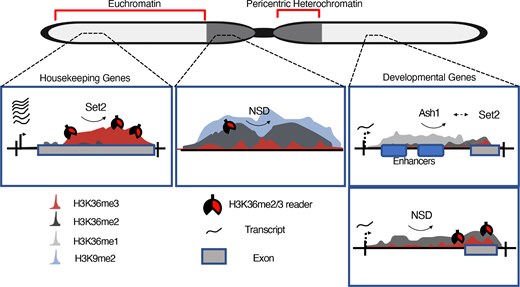-
PDF
- Split View
-
Views
-
Cite
Cite
Muhunden Jayakrishnan, Magdalena Havlová, Václav Veverka, Catherine Regnard, Peter B Becker, RETRACTED AND REPLACED: Genomic context-dependent histone H3K36 methylation by three Drosophila methyltransferases and implications for dedicated chromatin readers, Nucleic Acids Research, Volume 52, Issue 13, 22 July 2024, Pages 7627–7649, https://doi.org/10.1093/nar/gkae449
Close - Share Icon Share
Abstract
Methylation of histone H3 at lysine 36 (H3K36me3) marks active chromatin. The mark is interpreted by epigenetic readers that assist transcription and safeguard the integrity of the chromatin fiber. The chromodomain protein MSL3 binds H3K36me3 to target X-chromosomal genes in male Drosophila for dosage compensation. The PWWP-domain protein JASPer recruits the JIL1 kinase to active chromatin on all chromosomes. Unexpectedly, depletion of K36me3 had variable, locus-specific effects on the interactions of those readers. This observation motivated a systematic and comprehensive study of K36 methylation in a defined cellular model. Contrasting prevailing models, we found that K36me1, K36me2 and K36me3 each contribute to distinct chromatin states. A gene-centric view of the changing K36 methylation landscape upon depletion of the three methyltransferases Set2, NSD and Ash1 revealed local, context-specific methylation signatures. Set2 catalyzes K36me3 predominantly at transcriptionally active euchromatin. NSD places K36me2/3 at defined loci within pericentric heterochromatin and on weakly transcribed euchromatic genes. Ash1 deposits K36me1 at regions with enhancer signatures. The genome-wide mapping of MSL3 and JASPer suggested that they bind K36me2 in addition to K36me3, which was confirmed by direct affinity measurement. This dual specificity attracts the readers to a broader range of chromosomal locations and increases the robustness of their actions.

This article has been retracted and replaced. Please see https://doi.org/10.1093/nar/gkaf243 for details. The replacement article can be found at https://doi.org/10.1093/nar/gkaf202.




Comments